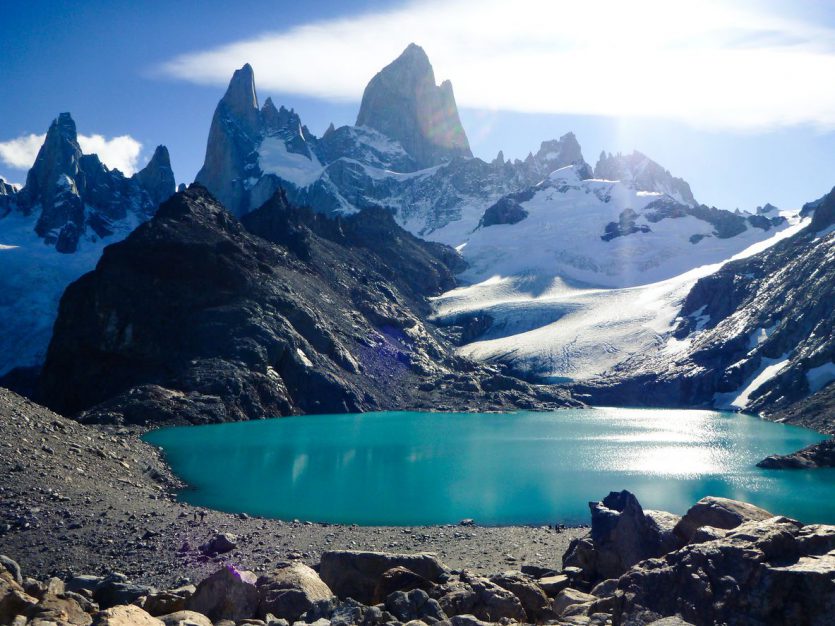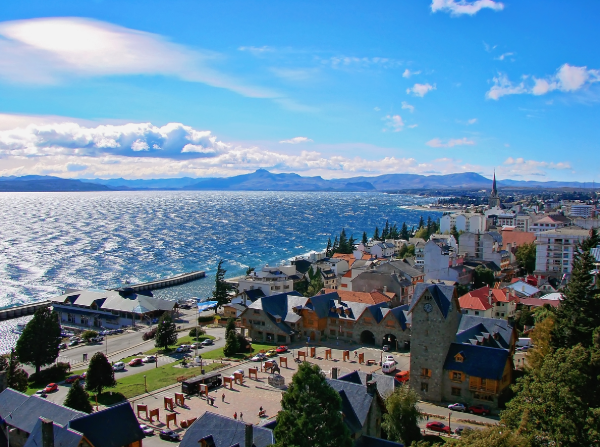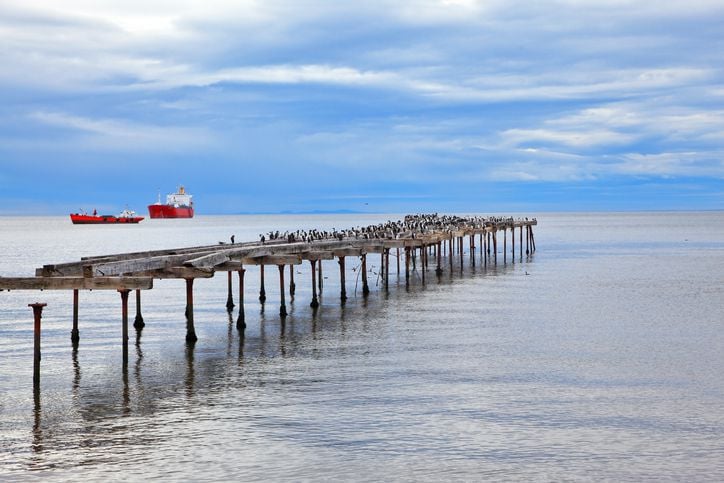Majestic Monte San Valentín stands out as a truly hidden gem in Patagonia. The highest summit in the Western Patagonia, its rugged beauty and untamed wilderness beckons adventurers from all over the world.
Monte San Valentín presents opportunities for all types of travellers: from expert climbers seeking to test their endurance to explorers wishing to catch sight of breathtaking landscapes.
In Monte San Valentín, travellers can expect one of the best adventure options in Patagonia, a realm where nature reigns supreme, bringing an opportunity to connect to this region’s true wild spirit.

Accessing Monte San Valentin: what are the options?
As with other adventure travel itineraries in Patagonia, accessing Monte San Valentin for optimal convenience is a key issue. There are three main options for taking the first step in the adventure:
- Flying into Balmaceda airport: located near Coyhaique, Balmaceda Airport serves as a gateway to the Aysén Region, where Monte San Valentin is located. From the airport, travellers can rent a car and embark on a scenic drive to reach a convenient starting point for the ascent, which typically involves nearby towns of Puerto Guadal, Villa Cerro Castillo or Cochrane.
- Driving to Puerto Guadal or Villa Cerro Castillo: another option involves driving to Puerto Guadal or Villa Cerro Castillo, which both serve as potential starting points for approaching Monte San Valentin. These small towns offer basic amenities and serve as convenient launching points for accessing the peak, including finding guided tours to Monte San Valentin.
- Taking a ferry from Puerto Montt to Puerto Chacabuco: this scenic journey through the stunning fjords of northern Patagonia takes longer, but it’s rewarded with outstanding fjord vistas. From Puerto Chacabuco, visitors can then drive (or arrange transportation) to reach the Aysén Region and continue their journey towards Monte San Valentin.
Regarding the starting point for the expedition, the choice should be guided by awareness of skill levels and what the actual adventure in Monte San Valentin will be like.
As such, beginners or those looking for a less challenging approach are advised to proceed to Laguna Toro via the main trail to Paso de los Vientos at 2,400m. This serves as a beginner-friendly route, with a well-defined trail and relatively moderate terrain.
However, most adventurers choose Cochrane as a common base due to its proximity to Monte San Valentin, as well as the availability of accommodation options. From Cochrane, visitors can organise transportation, obtain supplies, and gather information before setting out on their journey towards the peak.
Activities in the Region: what to do in Monte San Valentin
Monte San Valentin offers a diverse array of outdoor activities, thus catering to adventurers of all skill levels and interests.
Hiking and trekking
Hiking and trekking take a new meaning in Patagonia’s astonishing nature, and Monte San Valentin is no exception. The area boasts numerous trails through pristine valleys, forests and glaciers, all ranging from easy walks to multi-day treks for experienced adventurers.
Mountaineering experiences
Seasoned explorers with a taste for a challenge can embark on mountaineering experiences in Monte San Valentin, an arduous ascent that rewards climbers with unparalleled views. Additionally, glacier trekking represents yet another adrenaline-filled activity for experienced adventurers, as the Northern Patagonian Ice Field presents multiple unique opportunities: from traversing ancient ice formations and crevasses to exploring ice caves. Skiing and other snow-related sports represent yet another reason for mountain aficionados to visit Monte San Valentin.
Wildlife
However, Monte San Valentin offers plenty of other options beyond these. Its surrounding wilderness ensures magical wildlife and bird watching opportunities, including the elusive Andean condors and guanacos, among other animal species.
Additionally, Patagonia trip planning guides often involve Monte San Valentin for endless opportunities for photographic trips. From sunrise over the peaks to plays of light on glacial ice, every moment in Monte San Valentin is a potential masterpiece.

Historical Significance of Monte San Valentin
Monte San Valentin has a coveted status among climbers. Located in one of the most rugged and inhospitable regions of Patagonia, it has gained a reputation due to its stunning beauty and remote location.
The first of attempts to ascend were undertaken in the 1920s, but it wasn’t until the mid 20th century that the first successful climb took place. Since then, the mountain has continued attracting climbers from around the world to push the limits of mountaineering and attempt new routes. For instance, the American elite alpinist Alex Lowe completed a daring solo ascent of the West Ridge in 1991.
The Best Time to Visit Monte San Valentin
At Monte San Valentin, the time of the year has a big impact on the types of available activities.
Summer
During the summer months (from December to March), Patagonia offers longer daylight hours and milder temperatures. This makes it the perfect time for hiking and mountain climbing expeditions. Warmer temperatures also facilitate glacier trekking and wildlife watching, as many species are more active during this season.
Winter
However, those looking for snow-related activities and unique frozen vistas should visit in winter (June to August). While unpredictable weather conditions are the norm in Patagonia regardless of the season, visitors in winter should wear appropriate clothing and gear for cold and potentially harsh conditions.
Climate and Preparation
Preparing for the unpredictable weather of Patagonia requires careful planning and appropriate gear.
Conditions during the summer involve day temperatures around 60°F but descending to sub-zero levels at night. Potential snow storms or strong winds or rain may also take place. During the autumn and winter, significant declines in temperatures and a higher probability of storms can be expected.
This means travellers visiting Monte San Valentin should pack clothing suitable for a wide range of weather conditions: from waterproof and windproof layers to insulated jackets, sturdy hiking boots, and moisture-wicking base layers.
Moreover, climbing accessories such as ice axes or crampons are essential for undertaking certain winter ascents in Monte San Valentin, all while ensuring proficiency in their use. Additional gear may include shelter and sleeping equipment, navigation tools and emergency supplies.
All in all, consulting local guides and weather forecasts is essential to understand weather patterns and conditions and ensuring expeditions are ready and plans adjusted based on the forecasted conditions.
Accommodation Options in Monte San Valentin
Accommodation options around Monte San Valentín cater to a wide range of preferences and budgets. These options typically include:
- Budget-friendly cabins and guest houses with basic amenities, such as shared bathrooms and communal spaces
- Mid-range hotels and lodges, which strike a balance between comfort and affordability
- Luxurious lodges and hotels for travellers looking for unparalleled comfort and service
Regardless of the type of accommodation chosen, advance booking is highly recommended, especially during peak season (December to March) and during major holidays.
8-day Suggested Itinerary for Monte San Valentin starting from Villa O’Higgins
Day 1: Arrival in Villa O’Higgins
The adventure begins at the charming Villa O’Higgins, where explorers can spend the first day settling into their accommodation, exploring the unique town and preparing for the adventure ahead.
Day 2: Trek to Refugio Mañihuales
Rise early for an unforgettable 7-hour trek to Refugio Mañihuales, a refuge that serves as a base for mountaineers preparing to conquer Monte San Valentin. During the trek, adventurers will walk among lakes, forests, and awe-inspiring glaciers.
Day 3: Acclimatisation
The high altitude at Monte San Valentin means a day is needed to acclimatise, ensuring the climb is done safely.
Day 4-6: Summit Monte San Valentin
Setting out before dawn on the fourth day, an epic ascent spanning 2-3 days begins. Explorers will traverse rugged terrain including snow-covered slopes and glacier crossings, all leading to breathtaking panoramas of the Southern Patagonian Ice Field and the surrounding peaks.
Day 7: Descent
Having conquered the summit, explorers can begin their descent back to Refugio Mañihuales in order to spend the night in the refuge.
Day 8: Departure
Return to Villa O’Higgins as the journey draws to a close.
The Routes to the Summit
Northwest Ridge
The ideal route for intermediate climbers, it offers a challenging yet manageable ascent. Often beginning from Lago Leones, it leads hikers through rocky terrain and snowfields beyond the glacier, where camp bases can be established on the way towards the summit.
West Ridge
This route is reserved for experienced mountaineers, as it involves a precipitous ascent and other significant challenges that involve technical climbing. A truly thrilling adventure for those looking for a challenge and are prepared for its physical and mental demands. The rewards include vistas of San Rafael Lagoon and the Patagonian ice fields.
South Face
This represents the most demanding route in terms of advanced alpine mountaineering skills. Steep snow and ice slopes, rockfall hazards and route-finding challenges await those choosing this route, including an itinerary along a breathtaking inclining frozen facade.
Embark on your Monte San Valentin adventure!
Nestled within the heart of Patagonia, Monte San Valentin has captivated the imagination of adventurers around the world. Offering a remote wilderness experience, its pristine landscapes make it an ideal destination for adventurers seeking to challenge themselves against one of Patagonia’s most majestic peaks.
If you’re looking for the breathtaking landscapes of towering glaciers, turquoise lakes, and sharp peaks, Monte San Valentin awaits you. A truly memorable experience that blends adrenaline pumping with soul-stirring beauty.
FAQs
Where is Monte San Valentín?
Monte San Valentín, also known as Cerro San Valentín, is the highest peak in the Southern Patagonian Ice Field, located in the Aysén Region of Chile. This majestic mountain rises to an elevation of about 4,058 metres (13,314 feet) above sea level, making it the tallest mountain in Chilean Patagonia.
What to do at Monte San Valentín?
Monte San Valentín offers a range of activities for adventurers and nature enthusiasts. The primary attraction is mountaineering, as the peak presents a challenging climb for experienced alpinists. Besides climbing, the area around Monte San Valentín is ideal for trekking, glacier tours and exploring the Southern Patagonian Ice Field. Visitors can also engage in photography, capturing the stunning landscapes that comprise towering mountains, expansive ice fields, and serene glacial lakes.
When to go to Monte San Valentín?
The best time to visit Monte San Valentín, considering the challenging weather conditions of the Patagonian region, is during the Southern Hemisphere’s summer months, from December to March. During this period, the weather is relatively milder, and daylight hours are longer, providing more favourable conditions for climbing and trekking
No comments yet
There are no comments on this post yet.




Leave a comment